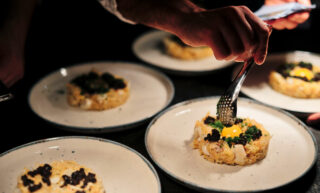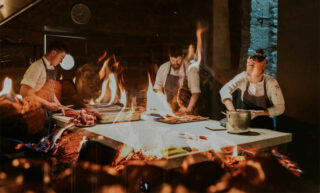Towards an inclusive, sustainable culinary identity
The Netherlands and food – it is a combination that doesn’t make headlines very often. If you asked a Dutch person about their national cuisine, you would probably get a quizzical look or an allusion to stamppot (mashed potatoes with vegetables and bacon). But outside the international limelight, the Low Food Movement, a group of passionate food professionals, is working hard to establish a new eetcultuur (eating culture) and a new national gastronomic identity. Joris Bijdendijk, executive chef at two one-star restaurants in Amsterdam, and Nadia Zerouali, author of cookbooks, a TV cook and the owner of the Couscous Bar, also in the Dutch capital, are their most public figures.
A couple of years ago, Joris Bijdendijk, the successful chef of restaurants Rijks and Wils in Amsterdam was asked to cook for the Prime Minister of the Netherlands, Mark Rutte. It was not long after Bijdendijk had published his book Een keuken voor de Lage Landen (a cuisine for the Low Countries). His agenda was too busy to cook at such short notice, but Bijdendijk asked for and got the opportunity to officially hand over a copy of his book to the Prime Minister. The chef used the occasion to ask Rutte to do more to foster a Dutch gastronomic tradition and support the dwindling number of artisan, small-scale and sustainably working farmers. Not knowing what to do, Rutte put Bijdendijk in touch with the Minister of Agriculture Carola Schouten, who advised the chef and some of his culinary companions to establish a foundation that would pursue those goals. Low Food was born.
Revaluation
Low Food, the founders having their roots in the Slow Food Youth Movement, wants to put Dutch food culture in the lead when it comes to “forward thinking on subjects [such] as sustainability and inclusion”, as the organisation’s website says. But first, a food or eating culture needs to be established, a task that may take a generation to complete, as Diego Prado Vasques, a South American culinary scientist currently residing in Copenhagen, shared in one of Low Food’s first events. However, with its enormous agricultural history, beautiful fish, seafood (mussels, oysters, grey shrimp) and seaweed from the North Sea and the estuaries of Rhine, Meuse and Scheldt, and a rich variety of poultry and livestock, it is more of a revaluation of what the country already has, than building something from the ground up.
As Bijdendijk explains, to attain the organisation’s goals the Low Food Movement consists of three pillars: the chef’s academy, research, and an annual symposium plus a number of other events to reach and include as many people as possible.
Joris Bijdendijk ©Rinze Vegelien
Co-created by students
Zerouali, spontaneous, talkative and sporting a full head of long curly black hair, explains how the academy is not a one-way street where Low Food tells participants how to do things. The program is co-created by the students who already have a (nascent) career in gastronomy. The six-day academy will lead to a full-fledged three-year program embedded in the Dutch educational system, scheduled to start in 2022 and consisting in large part of internships and “learning on the job”.
Forgotten grain and duckweed
The research arm of the organisation focuses on three main topics: waste, biodiversity and protein transition. Bijdendijk, mid thirties, wavy blond hair and a fashionable beard, gives examples. To reduce waste, members of his teams are looking into ways to use leftover vegetables and vegetable parts to make deeply flavoured umami broths. To boost biodiversity at restaurant Wils, the team bakes excellent bread from forgotten grains like einkorn, emmer and red wheat. And to reduce meat consumption Low Food does experiments with water lentils or duckweed. With one hectare of duckweed producing ten times more protein than soy, this floating plant holds great promise. However, it isn’t admitted to the market as an edible product. While Bijdendijk and his team try to find ways to make it tasty, for example through fermentation, Wageningen University (Life Sciences), looks into methods to grow duckweed as a crop for human consumption.
Nadia Zerouali ©Nadia Zerouali
Heri heri
In all its activities, Low Food strives to work with and reach people who represent the entire population of the Netherlands. Inclusion, more than sustainability, is a topic that needs attention. “The cliché image of Dutch food culture still is a stroopwafel and a piece of cheese on a cocktail stick with a little flag,” says Bijdendijk. “But it is much broader. Do you think a Hindu-Surinamese family can identify with cheese and a stroopwafel”, he asks. And here something contradictory pops up, because, as Zerouali and Bijdendijk believe, its open, multi-ethnic culture is one the Netherlands’ biggest culinary assets. In which other country would a Dutch-Moroccan wedding couple serve Japanese sushi? Zerouali herself, born and raised in the provincial Dutch town of Winterswijk from Moroccan parents and identifying as 100 per cent Dutch and 100 per cent Moroccan, is professionally involved in cooking the traditional heri heri meal, a part of the annual Keti Koti celebration that marks the abolishment of slavery in Suriname. In short, what Low Food wants is to create an eating culture and gastronomic identity that is inclusive of all people (regardless of colour, background, religion, etcetera), and absorbs all their culinary traditions.
Work in progress
As I bring up that embracing such an international approach may run counter to the aim of sustainability – transportation of produce from all over the world could leave an undesired carbon footprint – Bijdendijk seems unperturbed and emphasises it is a good point for Low Food to look into. Low Food is a work in progress. Asking questions is as important as answering them. However, anticipating a more definite answer, we already see that many traditionally imported products, like the Madame Jeanette chili or saffron, are now produced locally. Bijdendijk himself is an ambassador of Dutch made soy sauce.
Trickling down
Meanwhile the Dutch quest to earn recognition for their culinary achievements hasn’t remained unnoticed. The latest Best Chef Award ceremony took place in Amsterdam, and, in a field of global competitors, no fewer than ten Dutch chefs made it onto the top 100 chart, with Bijdendijk ranking 46. The more prestigious list of the World’s 50 Best however, doesn’t seem to have picked up the trend yet. Surprisingly. Even Michelin, not always the fastest in its recognition, has acknowledged the huge strides Dutch gastronomy has made over the last decade. It demonstrates that at the top end a lot has changed, in its slipstream also creating a lively scene of excellent, more affordable restaurants in the middle segment. The trickle-down into a general eating culture may still take some time.
RIJKS restaurant ©RIJKS
Blaarkop cow
Bijdendijk is still full of ideas and ambitions. He sees himself quite rightly as a long-term thinker. For his restaurants in Amsterdam he uses long timelines, albeit with ten years much shorter than a generation. He strives to raise the quality further and findings from Low Food need to be incorporated. Over time he has come to realise that not only Dutch hard cheeses are world class, now he is also convinced the country’s artisinal soft cheeses, like Machedoux (a raw milk white flora goat’s cheese from Groningen) or Lazuli (a blue cheese from pasteurized cow’s milk from Utrecht) are top quality. They are currently part of the cheese trolley to illustrate that what may seem French, can actually be Dutch. However, one of Bijdendijk’s signature dishes, an all-dairy dessert made of the milk of the rare local Blaarkop cow used for Leidsche kaas (literally: cheese from Leiden) is an indicator of what else he is capable of doing with (milk and) cheese. It consists of the following parts: A traditional boterkoek (butter cake) spiced up with a bit of Leidsche kaas, an ice cream made of buttermilk on top of a crumble of cheese, a fatty foam of cheese and a more ethereal foam made from a broth of the cheese’s crusts. To prove that nothing has to go to waste, the remaining gooey, chewy crusts (a bit like bubblegum) are rolled out and baked into crispy cookies providing crunch to this utterly Dutch creation.
Gallery of Honour
In an attempt to carry through with the idea of sourcing locally even further, Bijdendijk also revamped Rijks’ wine list during lockdown. While the list used to read like the who-is-who of Dutch vintners, often practicing their skill abroad, now the heart of list is made up of the best wines from the country’s own soil, grouped into the so-called Gallery of Honour, named after the part of the Rijksmuseum where Rembrandt’s Nightwatch is hanging. Given that a generation ago nobody in the Netherlands would have given a dime for the idea of a Michelin-starred restaurant serving seriously good Dutch wines, we may as well start to believe that forty years from now the Netherlands will have a world-class eating culture that is sustainable and inclusive to boot. As it stands, that moment may actually come much sooner. Once it’s there we may give Bijdendijk, Zerouali and their fellows at the Low Food Movement a significant chunk of the credit.
Low Food
Other than Bijdendijk and Zerouali, the board of Low Food consists of Joris Lohman and Samuel Levie. Lohman is co-founder of Food Hub, an organisation creating new innovative forms of food education. Its mission is to drive the transition to a sustainable, honest, delicious and healthy food production chain.
Levie is co-founder of Brandt & Levie, maker of sausages from ethically sourced meat, and of Food Cabinet, a campaign agency that works with its clients on the food production of the future.
Joris Bijdendijk
Joris Bijdendijk started his career in the kitchen of Le Jardin des Sens (two stars) of the Pourcel brothers in Montpellier. Subsequently, he was part of restaurant Ron Blaauw’s rise to fame (from zero to two stars). His first star Bijdendijk received as head chef at restaurant Bridges at The Grand in Amsterdam. He currently heads the kitchens at Rijks, housed in and named after the Rijksmuseum, and Wils, which carries the name of Jan Wils, the architect of the nearby Olympic Stadium.
Five Dutch restaurants and their chefs who Bijdendijk considers to be working in the same vein as himself and Low Food.
Choux – Amsterdam
Chef: Merijn van Berlo
All natural wine, sommelier: Figo van Onna
Circl – Amsterdam
Chef: Rudolf Brand
Local, sustainable, circular
Meliefste – Wolphaartsdijk
Chef: Thijs Meliefste
De Nieuwe Winkel – Nijmegen
Chef: Emile van der Staak
De Lindehof – Nuenen
Chef: Soenil Bahadoer
Addresses
Rijks Restaurant
Museumstraat 2, Amsterdam
+31 (0)20 674 7555
Restaurant Wils
Stadionplein 26, Amsterdam
+31 (0)20 236 6522
Couscousbar (two branches)
Javastraat 30, Amsterdam
Kinkerstraat 85, Amsterdam
+31 (0)20 331 4130
A version of this article (in Norwegian) has been published in Apéritif (issue 7 2021)





Comments